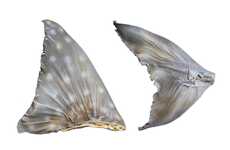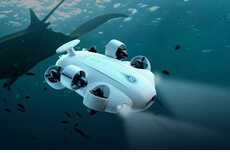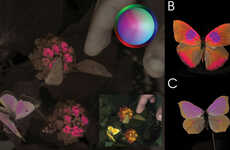
This Underwater Sonogram Captures a Pregnant Tiger Shark
Hayley McGlone — July 7, 2016 — Tech
Scientists from the University of New England have captured the never-before-seen footage of unborn sharks from the first-ever sonogram of a pregnant tiger shark. The successful sonogram is the first non-lethal method of viewing the uterus of a pregnant shark, and will allow scientists to further study the tiger shark and its reproductive patterns.
The shark, nicknamed Emily, is the four-meter long tiger shark that underwent the first shark sonogram. It is hoped that the sonogram can be used to study the reproductive cycles of other shark breeds as well. In an accompanying video, it is possible to see the shark pups' teeth and spins, as well as their outlines.
Emily is seen carrying 20 shark pups when in the revolutionary sonogram. This high number is not unusual among tiger sharks, with litters comprising 35 to 55 pups.
The shark, nicknamed Emily, is the four-meter long tiger shark that underwent the first shark sonogram. It is hoped that the sonogram can be used to study the reproductive cycles of other shark breeds as well. In an accompanying video, it is possible to see the shark pups' teeth and spins, as well as their outlines.
Emily is seen carrying 20 shark pups when in the revolutionary sonogram. This high number is not unusual among tiger sharks, with litters comprising 35 to 55 pups.
Trend Themes
1. Non-lethal Animal Sonograms - Non-lethal sonograms of animals present disruptive opportunities for scientific research and animal welfare.
2. Underwater Imaging Technology - Underwater imaging technology has the potential to revolutionize the study of marine life and has disruptive applications in oceanography and marine exploration.
3. Reproductive Studies of Marine Animals - Advances in reproductive studies of marine animals using non-invasive technology can provide valuable insights in the conservation and breeding of endangered species.
Industry Implications
1. Scientific Research - New non-invasive non-lethal techniques such as sonograms for animal experimentation could be transformative for scientific research, especially in animal welfare and reproductive biology.
2. Underwater Technology - The development and evolution of underwater imaging technology present significant opportunities for marine biology, conservation, oil and gas industries, and underwater engineering.
3. Conservation & Zoos - The use of non-invasive reproductive studies through technologies such as sonograms can enable conservation organizations and zoos to better study, protect and breed endangered aquatic species such as sharks.
1.5
Score
Popularity
Activity
Freshness















